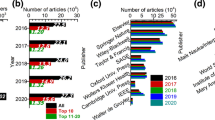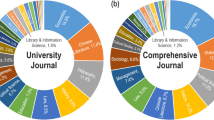Abstract
For academic research outcomes, there is an increasing emphasis on the bibliometric scorings like the journal impact factor and citations when the assessment of the scientific merits of research or researchers is required. Currently, no known study has been conducted to explore the bibliographical trends of the subject category of multidisciplinary sciences as indexed by the annual Journal Citation Reports of the Thomson Scientific. The effect of journal self-citations and intra-citing within a discipline to the bibliometric data computation can be confounding. In this study, six journals were selected from the multidisciplinary sciences subject category where the trend of self-citations and intra-citing were analysed. These journals were chosen as they published more than 450 citable articles in the year 2007 and had available bibliometric data for a 10-year period. The results showed that self-citations rose as much as +23.98% while intra-citing declined up to −5.80% over the observed period. The retrospective impacts and influences of these observations were also discussed in this study.








Similar content being viewed by others
References
Gami, A. S., Montori, V. M., Wilczynski, N. L., & Haynes, R. B. (2004). Author self-citation in the diabetes literature. Canadian Medical Association Journal, 170, 1925–1927. doi:10.1503/cmaj.1031879.
Fassoulaki, A., Paraskeva, A., Papilas, K., & Karabinis, G. (2000). Self-citations in six anaesthesia journals and their significance in determining the impact factor. British Journal of Anaesthesia, 84, 266–269.
Hyland, K. (2003). Self-citation and self-reference: Credibility and promotion in academic publication. Journal of the American Society for Information Science and Technology, 54, 251–259. doi:10.1002/asi.10204.
Nieminen, P., Carpenter, J., Rucker, G., & Schumacher, M. (2006). The relationship between quality of research and citation frequency. BMC Medical Research Methodology, 6, 42. doi:10.1186/1471-2288-6-42.
Smith, R. (1997). Journal accused of manipulating impact factor. BMJ (Clinical Research Ed.), 314, 461.
DeMaria, A. N. (2003). A report card for journals. Journal of the American College of Cardiology, 42, 952–953. doi:10.1016/S0735-1097(03)01001-5.
Bloch, S., & Walter, G. (2001). The Impact Factor: Time for change. The Australian and New Zealand Journal of Psychiatry, 35, 563–568.
Garfield, E. (2006). The history and meaning of the journal impact factor. Journal of the American Medical Association, 295, 90–93. doi:10.1001/jama.295.1.90.
Adam, D. (2002). The counting house. Nature, 415, 726–729.
Golubic, R., Rudes, M., Kovacic, N., Marusic, M., & Marusic, A. (2008). Calculating impact factor: How bibliographical classification of journal items affects the impact factor of large and small journals. Science and Engineering Ethics, 14, 41–49. doi:10.1007/s11948-007-9044-3.
Hirsch, J. E. (2007). Does the H index have predictive power? Proceedings of the National Academy of Sciences of the United States of America, 104, 19193–19198. doi:10.1073/pnas.0707962104.
Kinney, A. L. (2007). National scientific facilities and their science impact on nonbiomedical research. Proceedings of the National Academy of Sciences of the United States of America, 104, 17943–17947. doi:10.1073/pnas.0704416104.
Seglen, P. (1997). Why the impact factor of journals should not be used for evaluating research. BMJ (Clinical Research Ed.), 314, 498–502.
Habibzadeh, F., & Yadollahie, M. (2008). Journal weighted impact factor: A proposal. Journal of Informetrics, 2, 164–172. doi:10.1016/j.joi.2008.02.001.
Bollen, J., Rodriguez, M. A., & Van de Sompel, H. (2006). Journal status. Scientometrics, 69, 669–687. doi:10.1007/s11192-006-0176-z.
Glanzel, W., & Schubert, A. (2003). A new classification scheme of science fields and subfields designed for scientometric evaluation purposes. Scientometrics, 56, 357–367. doi:10.1023/A:1022378804087.
Institute for Scientific Information. (2009). Journal Citation Reports. Philadelphia, PA: Institute for Scientific Information, Thomson Scientific.
Seglen, P. O. (1994). Causal relationship between article citedness and journal impact. Journal of the American Society for Information Science, 45, 1–11. doi:10.1002/(SICI)1097-4571(199401)45:1<1::AID-ASI1>3.0.CO;2-Y.
Ioannidis, J. P. (2005). Contradicted and initially stronger effects in highly cited clinical research. Journal of the American Medical Association, 294, 218–228. doi:10.1001/jama.294.2.218.
Nakayama, T., Fukui, T., Fukuhara, S., Tsutani, K., & Yamazaki, S. (2003). Comparison between impact factors and citations in evidence-based practice guidelines. Journal of the American Medical Association, 290, 755–756. doi:10.1001/jama.290.6.755-b.
Callaham, M., Wears, R. L., & Weber, E. (2002). Journal prestige, publication bias, and other characteristics associated with citation of published studies in peer-reviewed journals. Journal of the American Medical Association, 287, 2847–2850. doi:10.1001/jama.287.21.2847.
Brown, H. (2007). How impact factors changed medical publishing – and science. BMJ (Clinical Research Ed.), 334, 561–564. doi:10.1136/bmj.39142.454086.AD.
Schutte, H. K., & Svec, J. G. (2007). Reaction of Folia Phoniatrica et Logopaedica on the current trend of impact factor measures. Folia Phoniatrica et Logopaedica, 59, 281–285. doi:10.1159/000108334.
Fava, G. A., Guidi, J., & Sonino, N. (2004). How citation analysis can monitor the progress of research in clinical medicine. Psychotherapy and Psychosomatics, 73, 331–333. doi:10.1159/000080384.
Acknowledgments
All the bibliographical data used in this study were obtained from the Journal Citation Report of the Thomson Scientific.
Author information
Authors and Affiliations
Corresponding author
Rights and permissions
About this article
Cite this article
Foo, J.Y.A. A Study on Journal Self-Citations and Intra-Citing within the Subject Category of Multidisciplinary Sciences. Sci Eng Ethics 15, 491–501 (2009). https://doi.org/10.1007/s11948-009-9118-5
Received:
Accepted:
Published:
Issue Date:
DOI: https://doi.org/10.1007/s11948-009-9118-5




